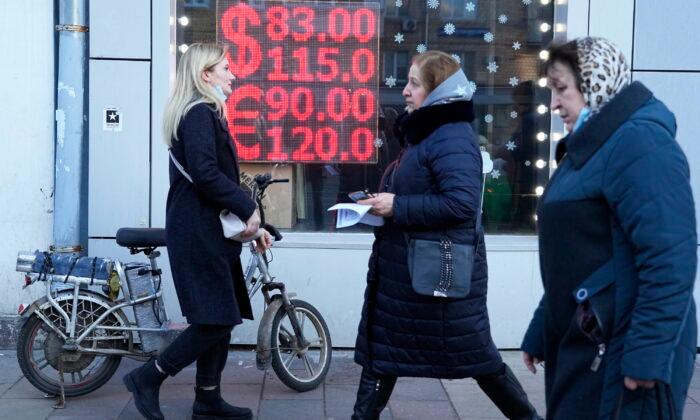Potential efforts to assist Russia to sell its oil and dodge Western sanctions have prompted fears about the survival of the global economic order. Some wonder if China and Russia’s continuous de-dollarization drive will expand, putting the U.S. dollar’s hegemony in the global financial system in jeopardy.
China has a large amount of dollar reserves and doesn’t allow its currency, the yuan, to be freely traded on foreign exchange markets. This restricts the usage of the currency in cross-border transactions.
While Beijing still relies substantially on the dollar, it has been trying to promote the yuan in its bilateral trade deals. China pushes for the usage of yuan in its Belt and Road Initiative (BRI), a massive trade and infrastructure project that seeks to revive the ancient Silk Road. Many BRI countries have already accepted the yuan as an official currency for trade with China.
“China theoretically has the ability to snap its fingers tomorrow and provide a solid counterweight to the U.S. dollar,” according to Christopher Balding, an expert on the Chinese economy and the author of “Sovereign Wealth Funds: The New Intersection of Money and Politics.”
But Beijing won’t allow that, and the reason is very simple, Balding says.
A Growing Alliance
Before the invasion of Ukraine, Moscow spent years attempting to shield itself from the effects of sanctions. After annexing Crimea in 2014, Russia dramatically curtailed its use of U.S. dollars. Its dollar reserves fell from almost 40 percent of the central bank’s stockpile in 2017 to 16 percent in 2021. The Russian government has sold off most of its U.S. Treasury assets and removed dollar assets from its sovereign wealth fund.In the face of deteriorating relations with the West in recent years, Russia and China have strengthened their economic, political, and military ties.

According to Balding, China also appears to be preparing for the possibility of strong sanctions or being cut off from global markets, in the event of an invasion of Taiwan. For example, they have a couple of years’ worth of wheat on hand, Balding said. Beijing has also been trying to secure its energy supply for years. China struck a 30-year gas supply deal with Russia’s Gazprom earlier this year. It’s also trying to boost the production of coal domestically to cut the need for coal imports.
The Western sanctions on Russia are giving Beijing a unique opportunity to boost the yuan’s status in international markets. Chinese officials hope that working with Russia will help them build a yuan-based financial infrastructure, including its Cross-Border Interbank Payment System (CIPS), which is a rival of the globally used Society for Worldwide Interbank Financial Telecommunication (SWIFT), and a bank card payment system.
And it’s not just Russia that wants to embrace the yuan. Saudi Arabia, whose relationship with Washington has cooled after President Joe Biden took office, is reportedly considering accepting the yuan instead of dollars for oil sales to China. China, the world’s top crude importer, buys more than 25 percent of the oil that Saudi Arabia exports.
Meanwhile, India is purchasing discounted Russian oil, and it’s exploring a rupee-ruble exchange scheme to circumvent sanctions.
“It’s just another event or stress test that’s proving that globalization is over,” according to Michael O’Sullivan, author of the book “The Levelling: What’s Next After Globalization.”
People are getting excited about this because they perceive it as a moment when the West’s financial dominance may come to an end, which is unlikely to happen, O’Sullivan told The Epoch Times.
“It’s very hard to see how the Chinese are really going to deepen the usage of their currency, particularly at a time when they’re alienating the Western world,” O’Sullivan said.
Economist Milton Ezrati believes that the de-dollarization movement could weaken U.S. global leadership in the long term.
But the question, he says, is how far it can go.
The U.S. dollar is no longer what it was decades ago, Ezrati admitted, but it remains the best option and is unlikely to lose its status anytime soon.
Since the Bretton Woods Agreement in 1944, the greenback has been the world’s reserve currency. According to the International Monetary Fund, central banks’ holdings of U.S. dollar reserves have decreased to 59 percent in 2021 from 71 percent in 1999.
The Federal Reserve is facing the highest inflation in decades and must raise interest rates further to control it, according to Ezrati, since this is the only way to safeguard the U.S. dollar’s position.
“The only best protection, if you want to maintain your position as a premier currency, is to secure its value in real terms. And that means to fight inflation.”





